Week six.
Welcome to my venture into travel-blog land. This is where I will write and post pictures (not too often because the photos seem to take ten years to upload, and I pay by the minute) and you can comment, or save any of the pictures you might want without me clogging anyone's inbox. I haven't been able to be too camera happy yet, because I'm still trying to gauge when and where it is appropriate to photograph people and things, but I've got a few good ones here.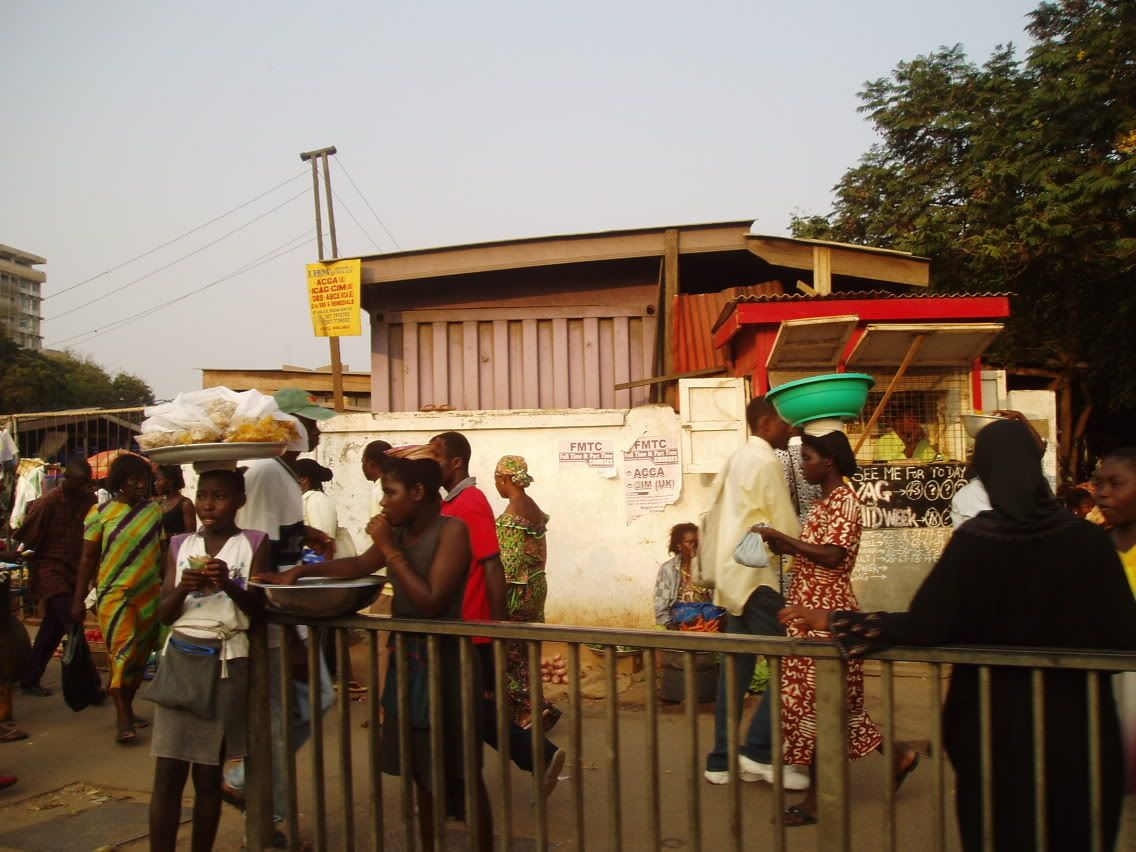 This is Accra. Nothing special, but I took this photo out the window of a tro-tro (a funky little mini unit of public transport that fits about 15-25 people) and I think it sets the scene of urban Ghana nicely. Notice the mix of western and traditional dress, the busyness, and the vendors selling their goods from ontop of their heads.
This is Accra. Nothing special, but I took this photo out the window of a tro-tro (a funky little mini unit of public transport that fits about 15-25 people) and I think it sets the scene of urban Ghana nicely. Notice the mix of western and traditional dress, the busyness, and the vendors selling their goods from ontop of their heads.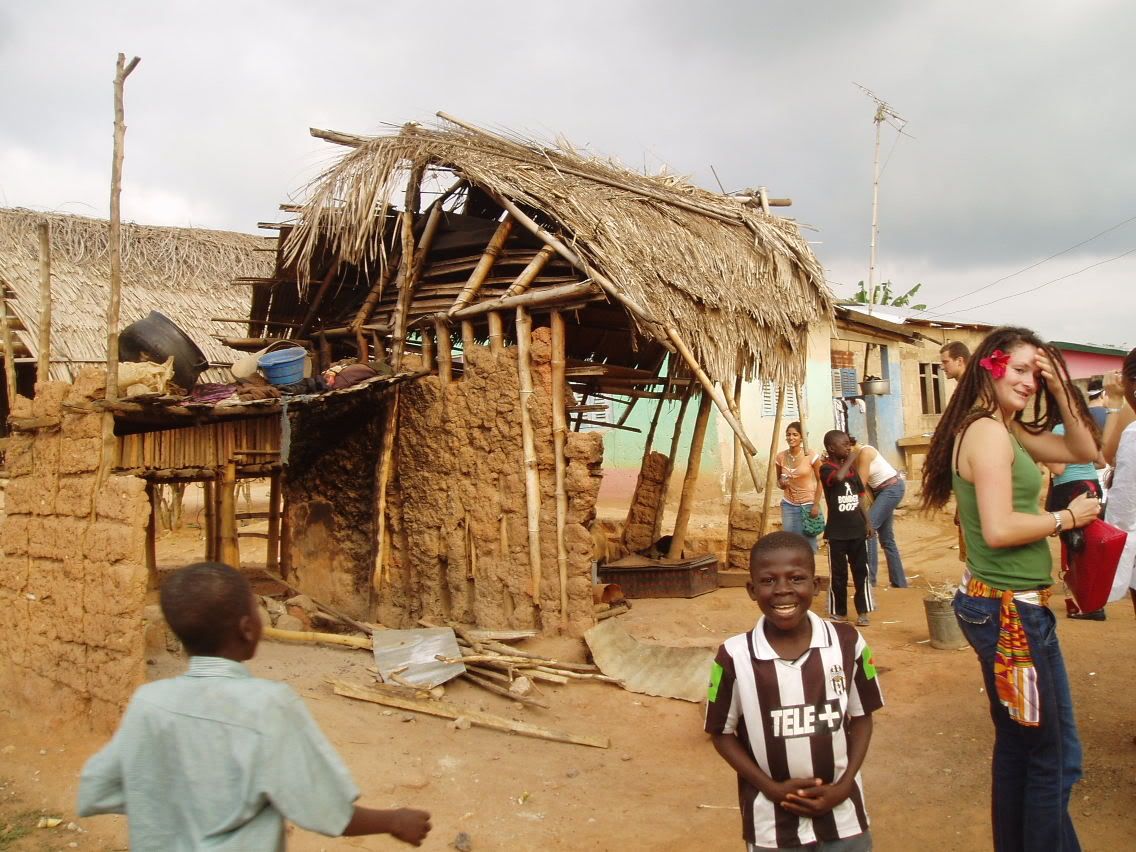 Here is a small bead village on the perimeter of Kumasi called Asamine. Before I moved up to Kumasi, while I was still in Accra with the rest of the UC students, we took a small trip to Kumasi and toured her satellite craft villages, this one specializes in bead making. The little boy in the center's name was Mandela. We had a few laughs. The beads were made by melting down old coca cola and fanta bottles in clay oven and mixing in pigments. We called it Ghanain recycling.
Here is a small bead village on the perimeter of Kumasi called Asamine. Before I moved up to Kumasi, while I was still in Accra with the rest of the UC students, we took a small trip to Kumasi and toured her satellite craft villages, this one specializes in bead making. The little boy in the center's name was Mandela. We had a few laughs. The beads were made by melting down old coca cola and fanta bottles in clay oven and mixing in pigments. We called it Ghanain recycling.
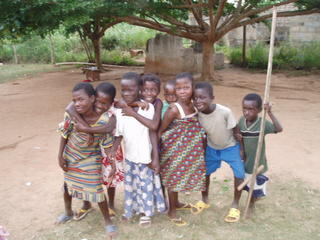
These were some of the kids from the bead village (Asamine.) In most villages, kids get really really excited when a batch of Obrunis (white folks) come through, in this village about thirty of them crowded around our bus jumping up and down and waving. Some of them asked for things like pens, candy, pennies, or contact information, most just wanted to hold our hands and introduce us to their families. The little girl in turquoise on her sisters back's name was Maggie, too. 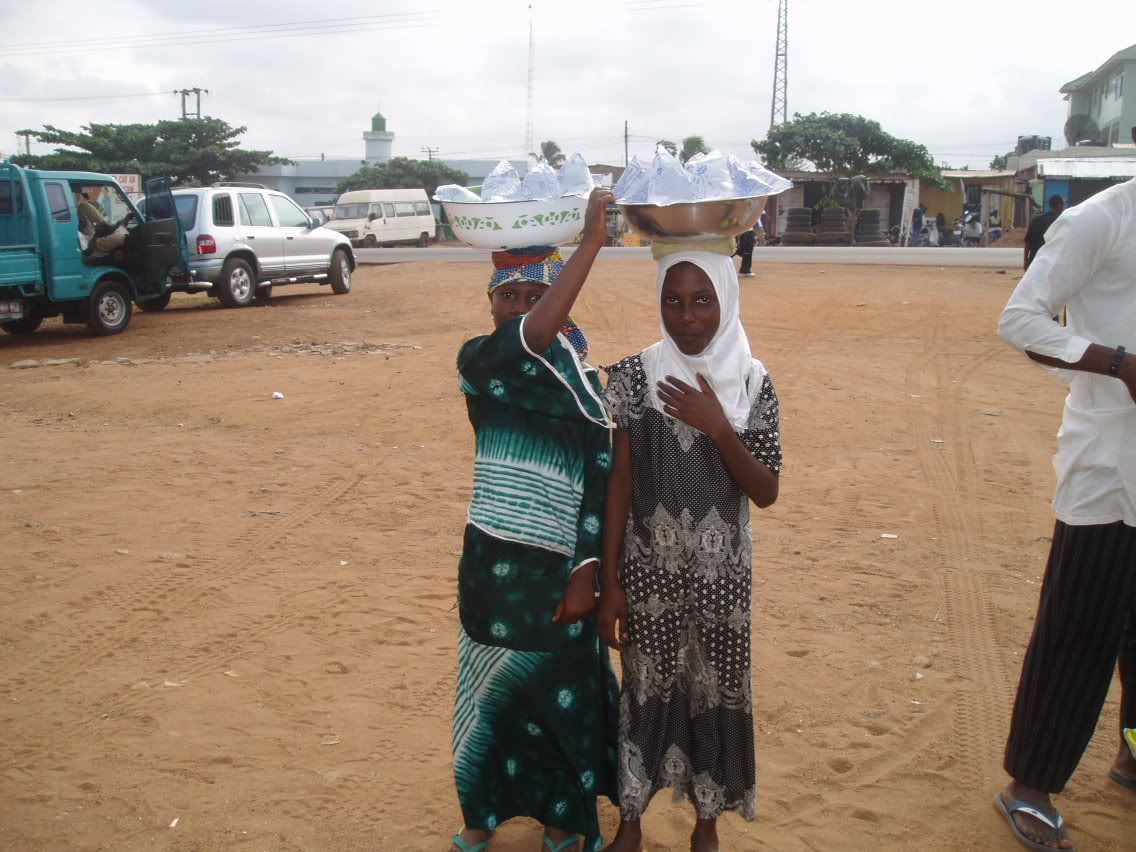 Two friendly girls selling water in Madina.
Two friendly girls selling water in Madina.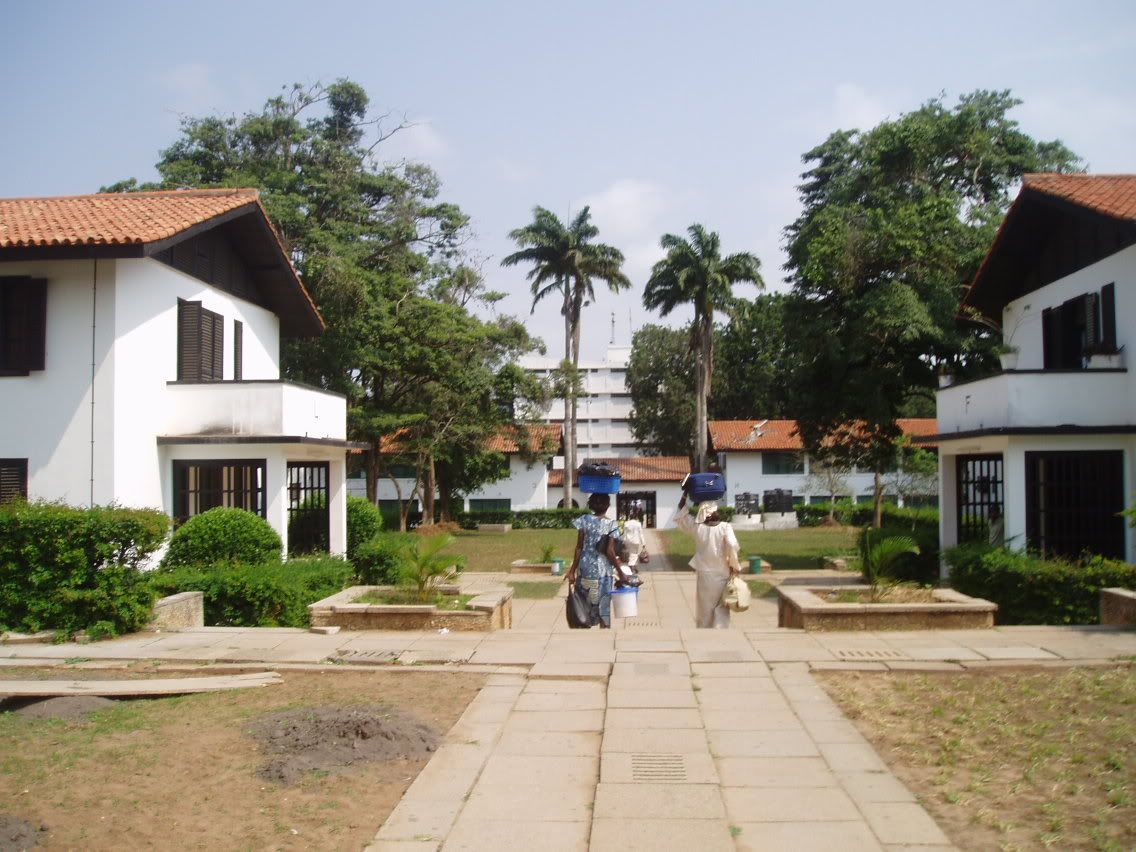 this is at the university of Ghana in Accra (where I spent the first three weeks in Ghana) its two women helping their children move in to the dorms. Note the big blue suitcases they each have balanced on their heads.
this is at the university of Ghana in Accra (where I spent the first three weeks in Ghana) its two women helping their children move in to the dorms. Note the big blue suitcases they each have balanced on their heads.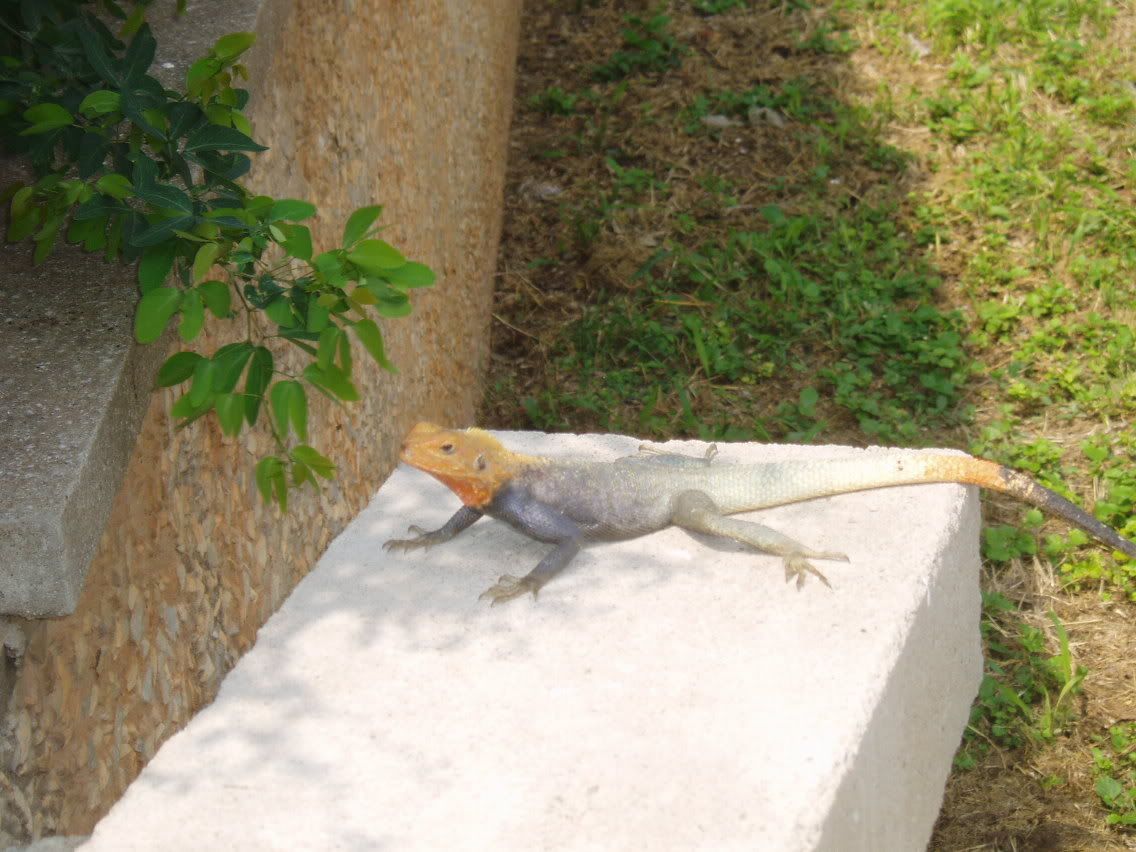 These things are EVERYWHERE. This was the first one I saw on my first afternoon in Ghana. I got really excited and crouched down quietly to try to capture it on camera, while my Ghanaian tour guide laughed and laughed at me. Now I just try to avoid stepping on them.
These things are EVERYWHERE. This was the first one I saw on my first afternoon in Ghana. I got really excited and crouched down quietly to try to capture it on camera, while my Ghanaian tour guide laughed and laughed at me. Now I just try to avoid stepping on them. Me and some of the other UC students drinking coconuts after a hot tro-tro ride in Accra.
Me and some of the other UC students drinking coconuts after a hot tro-tro ride in Accra.
A few weeks ago I got the opportunity to do a homestay with a family that lived in the hills outside a small-ish town called Nsawam (About 2 hours away from Accra en route to Kumasi) The family lived in a compound style home inhabited by two sisters, their respective husbands, brothers in law, and many children. The view from their gate looked out over the greenest hills, tall forested mountains ("where the giraffes live" according to the eleven year old, Maafua, which is most defiantly false, but a nice thought) and one small red dirt road leading away with chicks and roosters and little goats milling about. It wasn't until after the second meal that I realized that *everything* I was eating minus the fish came from the family's small subsistence farming, and those rolling green hills were providing everything this big healthy family needed to eat well: Yam, maize, cassava, plantains, paw-paw, coconut, oranges, mangos, palm nuts, palm oil, garden eggs, and lots of leafy greens. Since the purpose of the homestay was to get to learn how a ghanaian family operates, I participated in everything that the women did: I did laundry (by hand, mind you, and without running water) I helped cook, I pounded fufu and banku (common foods that require a lot of physical labor) I washed dishes (again, without running water) I played with the kids, I harvested dinner foods from the field, I fetched water from the well, (and carried it back on my head! You sure learn to appreciate how much water you use when you have to trek through the feilds with full buckets on your head to get it!) I even tied little baby Nana Kwame (five months old, and sweet as pie) on my back and carried him to the market, which got a lot of giggles from the locals. The children (nine of them, all girls besides baby Nana Kwame) and my host mother called me sister Afua ("sis-taa-fwa!" Afua meaning "Friday born"-In Akan communities like that of my Fante host family, at least one of the names a child gets is for the day of the week the baby was born on, and they are given the name on the eighth day of their life, in celebration of their first full week of life) On Sunday, I attended church with them in town, which was delivered completely in Twi, so I understood virtually none, but enjoyed watching everyone in their Sunday best (people really go all out with beautiful attire on sundays) and I loved their hymns! In the evenings I watched Asian soap operas dubbed over in English with my host parents, and told them about America. We all got along very well, and they invited me to come back anytime, maybe even for the holidays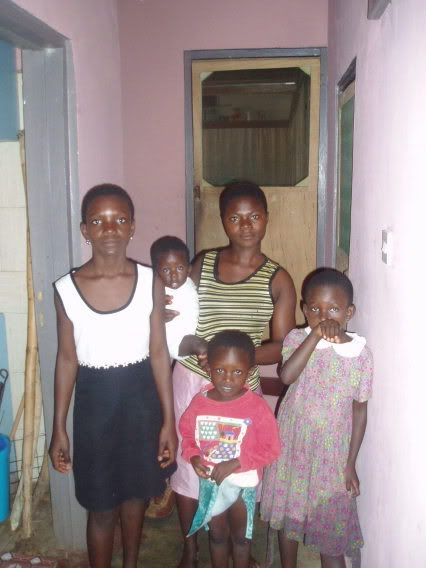
Maafua, Nana Kwame, Yaa, Erica, Maabina
the front yard..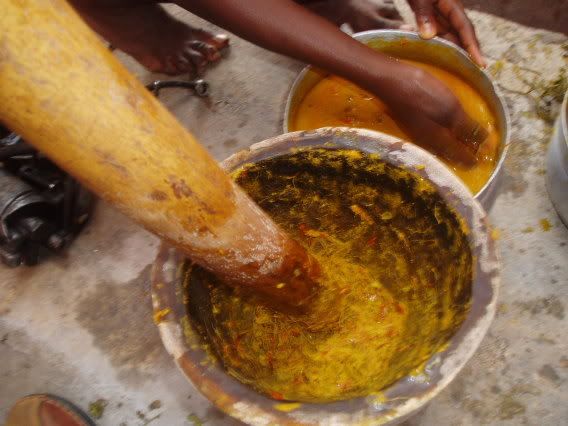
me and maafua pounding palmnut soup.
That's an ant hill! The girl next to it, Yaa, is about my hieght, and thats a medium sized hill.
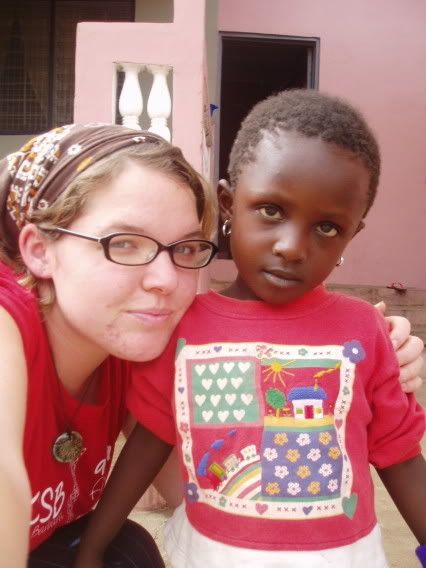
me and erica (she was my secret favorite, very spunky)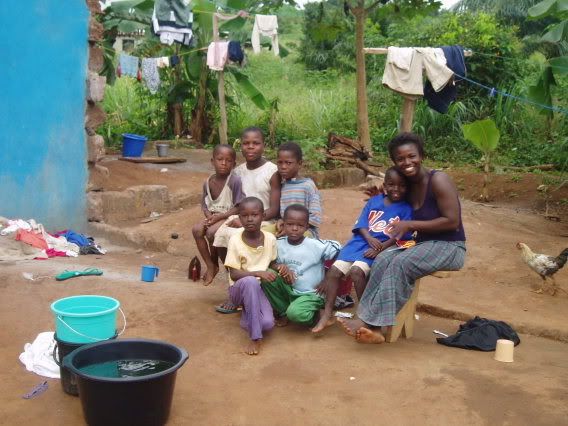
The next door neighbors (they were about a six minute walk away)
hopefully I'll see them again soon.
The day after I got home, after eating at one of the nicer joints on campus, called "Tacobell" which is basically Ghanaian food with french fries optional, I went with a small group of friends to the world famous coffin makers in Osu, Accra.
They make coffins in the shape of whatever the deceased did as profession or loved to do when he or she was alive... see below:
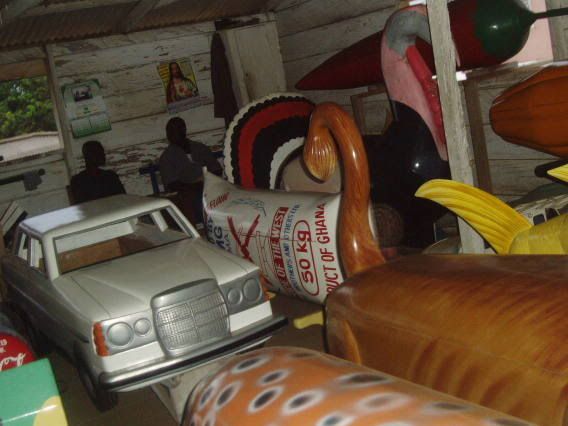
a chili pepper "for a salsa dancer" (salsa is huge here!) a turkey, a sack of grain, a car a coke bottle, and the ends of a cocoa bean, a fish, a lion and a cheeta... ive seen airplains, crabs, ears of corn, huts modled after the home of the dead, beer bottles... anything you can imagine!
the insides of a child size coke bottle coffin.
A few weeks ago, while I was still in Accra, the group took a trip to the old slave trade forts and castles at Elmina and Cape Coast, which was totally and absolutely chilling. We had a series of lectures leading up to our visit about the diaspora, the slave trade, and African slavery within Ghanaian society, but nothing can really prepare one, as an American, to walk side by side with Africans, African Americans, white Americans, and Europeans through the old dungeons and tunnels and feel the history still reverberating off the walls, and discuss how it is still reverberating through our society today. It gave me plenty to stew about.
Cape Coast: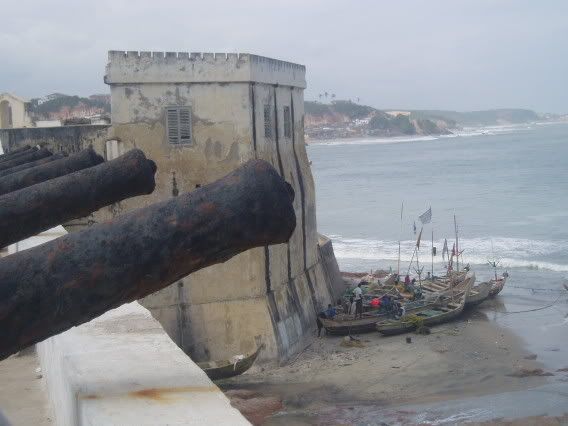
Elmina:
look how busy the town is below!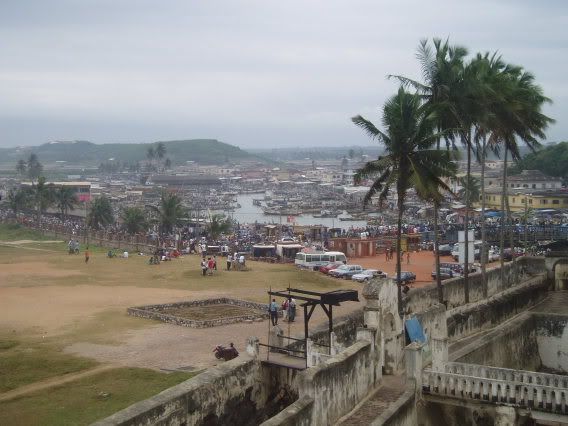
"the door of no return" that lead to the ships... they fit especially small, so the slaves would have to squeeze through, one by one, to prevent rebellion, or escapes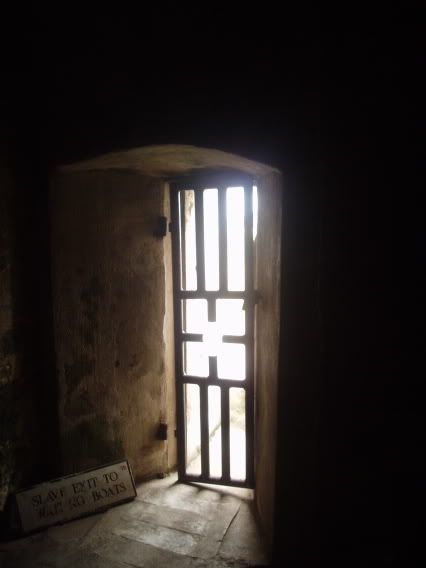
This was our tour guide. Notice his shirt, because its typical of modern Ghanaina culture. Instead of having a screenprinted "Tour Guide" shirt, his shirt is dyed with chains and white forts. Even the historical society of Ghana had dyed dresses that had its logo rather then a screen printed shirt. so cool.
more cape coast... fishermen outside the "door of no return"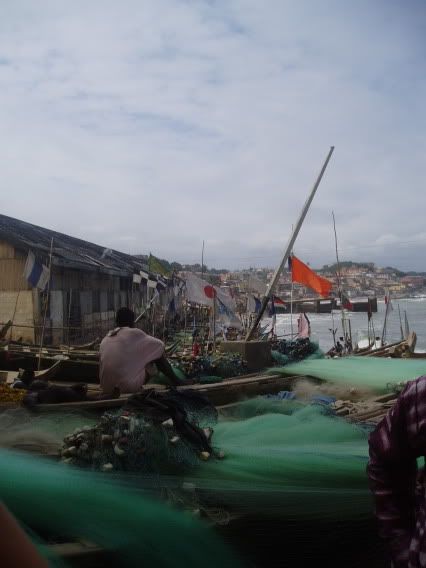
aaaaand... funny sign of the week: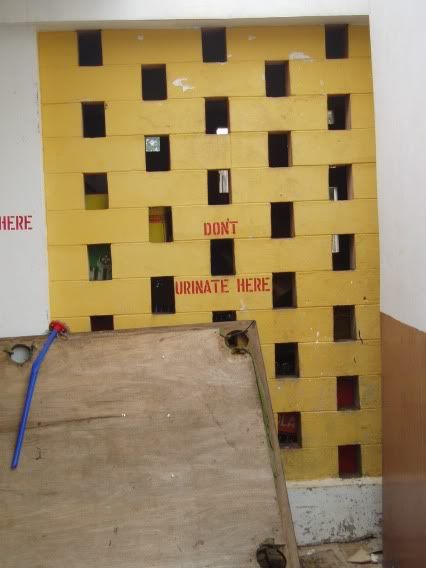
Cape Coast was the last trip I took with the California group before I left them for Kumasi. I was defiantly excited and ready to leave the flock of 30+ unavoidably invasive Californians and be on my own, and have since enjoyed the more subtle and quiet freedom Ive gotten, but the three week orientation was definatly nice and needed.
I've been in Kumasi now for about three weeks, nothing in terms of roommates or classes worked out the way I had planned, but they had told us to plan on remarkable inefficiency and slight chaos, so basically, I now live in a place endearingly referred to as "the basement" with a Ghanaian girl named Maame Esi (called "mommy" for short) not the friend Sena I had origionally planned on rooming with, but Maame, (a brilliant fourth year civil engineering student who always keeps me laughing) and I get along famously and the basement isn't anywhere as bad as it sounds. Classes started officially over two weeks ago, but I have yet to have the first lecture in about half of my classes.
I spent last weekend back with the Californians in Cape Coast where we met for a festivle. Those are the real pictures to look forward to, besides maybe those of the bull sacrifice. At least not for the faint of heart. More on that trip soon.
Its been quite an adventure so far. I'm finally starting to feel settled and at home, making good friends (with Ghanaians, Nigerians, and a small pack of students from U-dub) I am in good health and good spirits, but I do miss you all and hope to keep in better touch in the future.
Speaking of which, if anyone would like to write or call:
my cell number is 024 306 6898
and my mailing address is
UST- Maggie Muldoon
c/o Mrs Quashie Sam, registrar
Kwame Nkrumah University of Science and Techology
Kumasi, Ghana, West Africa.
keep in touch!
more pictures and notes to come soon,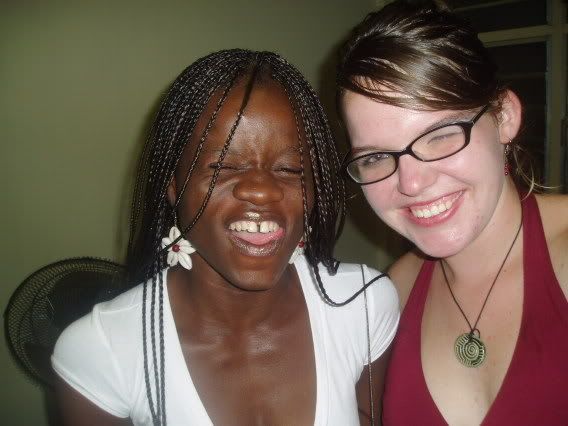
All my love, Maggie
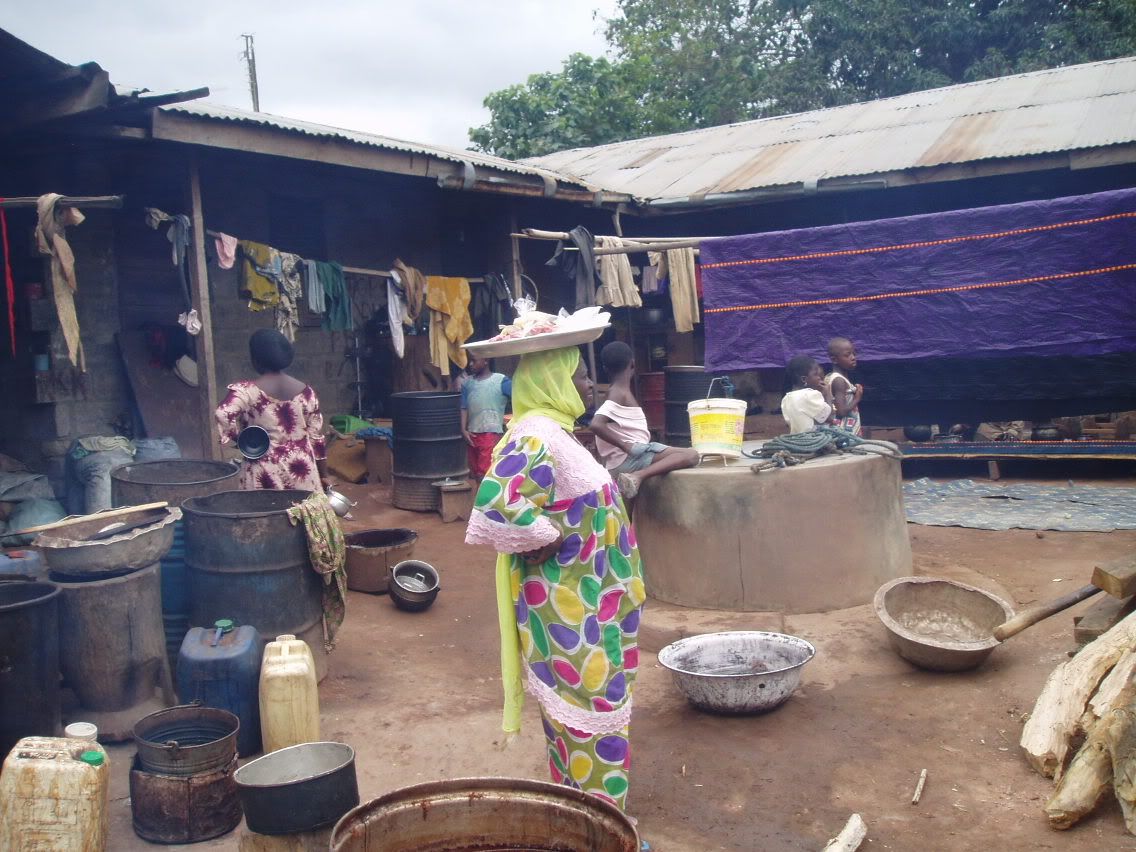
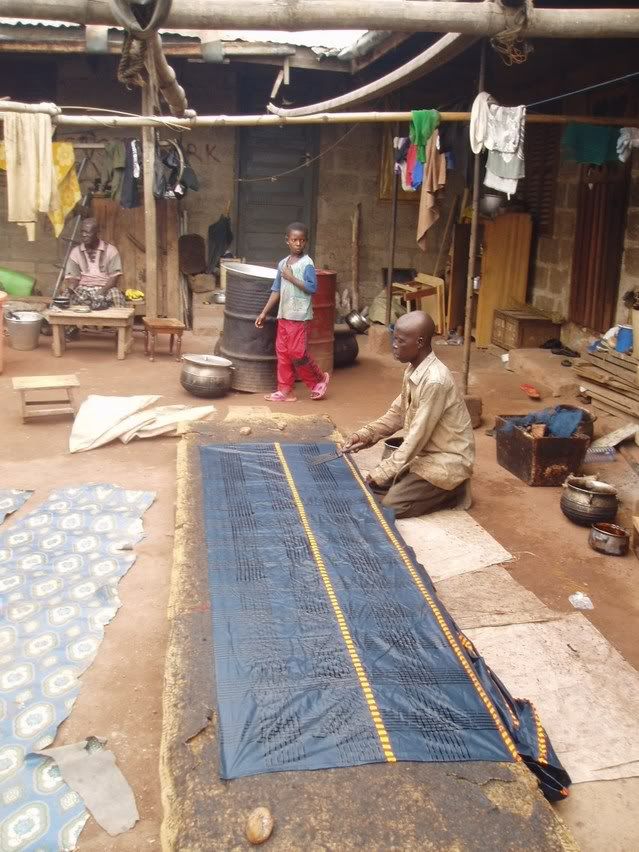
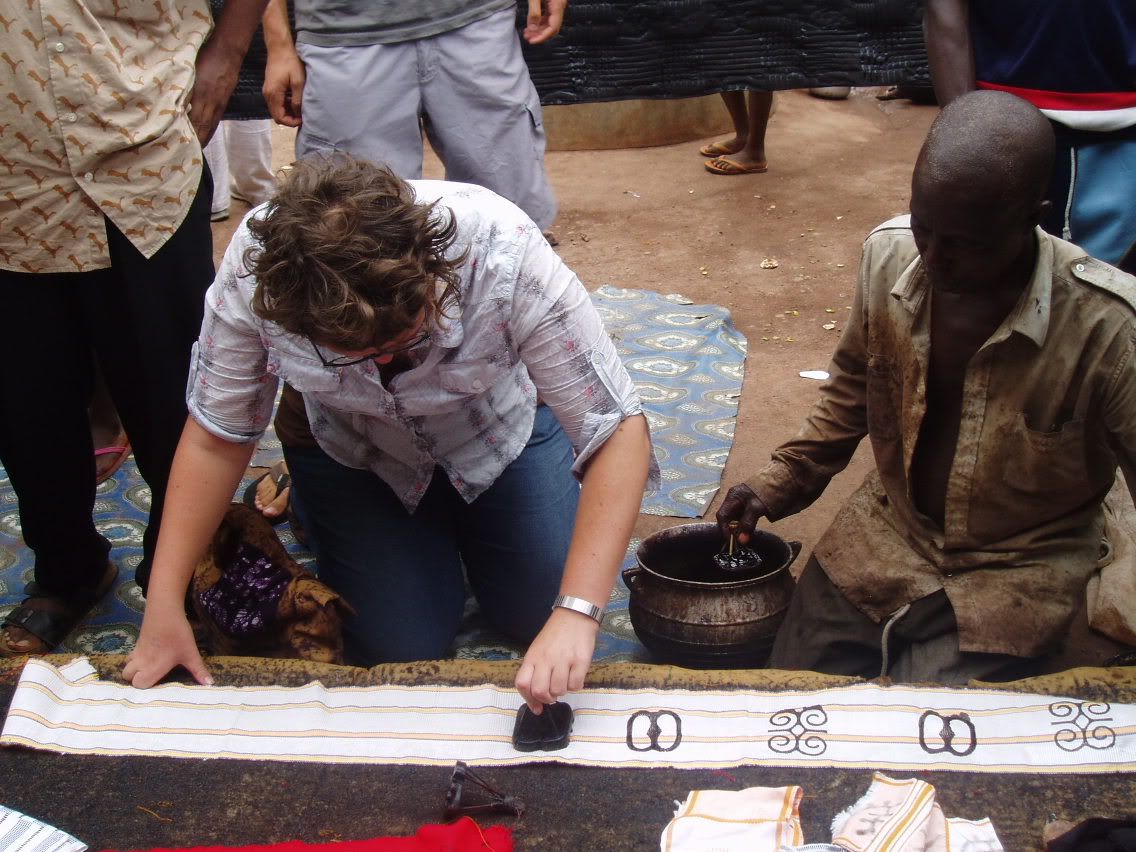

0 Comments:
Post a Comment
<< Home